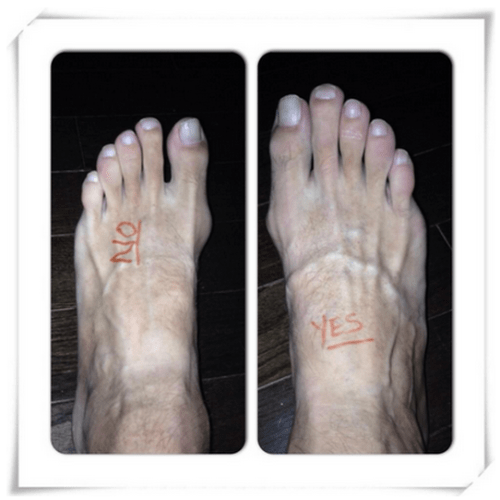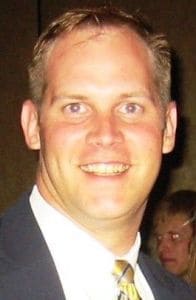Mark's Note: Today's guest post is by Chris Burnham. I invited him to write this after I saw him share his pre-surgical “poka yoke” (or error proofing) on Twitter (caution: picture of feet). I asked him if “anybody was offended” by his abundance of caution and interest in not having the wrong foot operated on. He replied, “No one was offended at all. I made it a point not to interfere with the point of incision.”
As the Continuous Improvement Leader in the facilities that I'm responsible for, I always try to live out what I was taught over a decade ago by my mentor:
Go See, Ask Why, Show Respect.
The first part of this, Go See, has become increasingly difficult this year because of pain in my right foot. Prolonged periods of walking or standing caused me enough pain to cause me to go see a podiatrist.
My podiatrist diagnosed the condition in my right foot as Morton's Neuroma, a benign tumor on one of the nerves in my foot that causes sharp, burning pain. A non-invasive course of treatment was attempted with a series of injections. But, ultimately, it was determined that I would need surgery.
I'm not the typical patient. My father is a retired vascular surgeon who was also a full professor of surgery at the University of North Carolina School of Medicine. Whenever I talk about my job, and when using data to help guide teams in solving problems at work or improving processes, Dad always has a comparative teaching story to share.
Throughout his career, my dad knew all of the data around the procedures he performed. Not only did he know all of the data around the success rates of the procedures he performed, he also knew the data around the performance of his peers. Whenever he noticed one of his peers doing exceptionally well, he would Go See, Ask Why, and Show Respect.
I followed my dad's example and started researching the data around my procedure when I knew surgery was a reality. I watched the procedure on YouTube and was able to read several medical studies on scholar.google.com. This enabled me to ask my surgeon several open ended questions that gave me a level of confidence in his decision making regarding choosing the surgical route and my care.
My biggest personal fear was having the surgeon operate on the wrong foot. The headlines are out there, everyone has heard a story from someone they “know”, and Mark has blogged about surgical errors as recently as last year. I was pleased that, in several process steps prior to my surgery, I was asked by multiple people about which foot was being operated on that day.
In addition to the different people asking me at various points in my intake process, they also marked the correct foot with a pen. When the pre-op nurse went to go mark my surgical site, she found where I had put my own poka yoke in place on the correct foot. I told her that I also had marked “NO” on the wrong foot as an additional protective step (as I shared on Twitter).

Ultimately, the most confirming step for me was when my surgeon inspected the additional mark the nurse had placed and confirmed with me that my right foot was the correct foot for the surgery.
I was extremely pleased with the overt presence of process. There were several other best practices I observed, including hand washing, distracting me with routine questions while the nurse placed my IV line, and the redundancy of different people asking me questions regarding medications, allergies, and the last time I ate or drank anything.
The entire lead time for me as the patient was just under two hours from intake to discharge. I never felt rushed, but I also never felt like I was needlessly waiting in a queue either. One of the nurses actually apologized to me for different people asking me the same questions over and over. I responded that “Repetition is a hallmark of excellence”. She replied that she would have to remember that one. I hope that she does for the sake of future patients.
 Chris Burnham is Regional Project Leader for Six Sigma & Continuous Improvement for a large third party logistics provider in Memphis, TN. He has been leading continuous improvement activities for over 10 years in a variety of industries. He is the author of 5S Simplified: How to Implement Workplace Organization to Achieve Success (with a new edition coming soon to Kindle). He works by the motto “Progress over Perfection” and invites you to connect with him on twitter at @RealBurnham
Chris Burnham is Regional Project Leader for Six Sigma & Continuous Improvement for a large third party logistics provider in Memphis, TN. He has been leading continuous improvement activities for over 10 years in a variety of industries. He is the author of 5S Simplified: How to Implement Workplace Organization to Achieve Success (with a new edition coming soon to Kindle). He works by the motto “Progress over Perfection” and invites you to connect with him on twitter at @RealBurnham
Please scroll down (or click) to post a comment. Connect with me on LinkedIn.
Let’s build a culture of continuous improvement and psychological safety—together. If you're a leader aiming for lasting change (not just more projects), I help organizations:
- Engage people at all levels in sustainable improvement
- Shift from fear of mistakes to learning from them
- Apply Lean thinking in practical, people-centered ways
Interested in coaching or a keynote talk? Let’s talk.
Join me for a Lean Healthcare Accelerator Trip to Japan! Learn More










[…] Recently I posted a picture of my personal poka yoke before my foot surgery on twitter. I was invited by Mark Graban, author of Lean Hospitals: Improving Quality, Patient Safety, and Employee Engagement, Second Edition to write a guest post for his blog about my experience. I’m grateful for the opportunity to speak to his audience about my experience. Here is my post. […]
This reminds me of when I had an ulnar nerve schwannoma removed from my left arm. It was pretty obvious which arm it was because the tumor was the size of a golf ball, but the question of “which arm are we operating on today” was still asked several times by nurses, surgeon, and anesthesia. They also marked the “no” arm as an added precaution.
As a surgery patient, I appreciated the extra caution. As a nerve tumor patient, I empathize with Chris’ pain.
A comment from a friend who is a patient safety expert:
“This actually introduces potential error. When draping and such are complete, sometimes you can’t see the entire marking. More than one wrong site surgery has been caused by this seemingly smart technique.
Proper technique is to mark the correct site, and nothing else.
There is no such thing as error-proofing. We humans are very inventive.”
I don’t think there is a true 100% poka yoke for wrong site surgical errors in the sense that you cannot put a USB cable into a USB port incorrectly because of design. I do believe in my case that surgical marking was part of a system of quality checks to protect my safety and prevent errors. In addition to marking, they asked me which foot often, and they even kept a sock on the foot that was not being operated on when they took me back to the operating room, leaving only my surgical foot exposed.
I also believe that there is an opportunity to standardize patient markings and teach it to students in medical school. Here is an example… People operating a vehicle understand how they should proceed when they see a stop sign, yield sign, or even a speed limit sign. Even though you are driving in different cities or states, the signs are fairly uniform. By standardizing patient markings a surgeon who sees a particular marking would know how to proceed.
If a necessary step like draping obscures a patient marking then perhaps a good kaizen opportunity would be to try and understand how patient marking and draping can work together to protect the process instead of potentially introducing an error.
I can completely understand and respect the patient safety expert’s opinion that in some cases less is better.
Comments are closed.